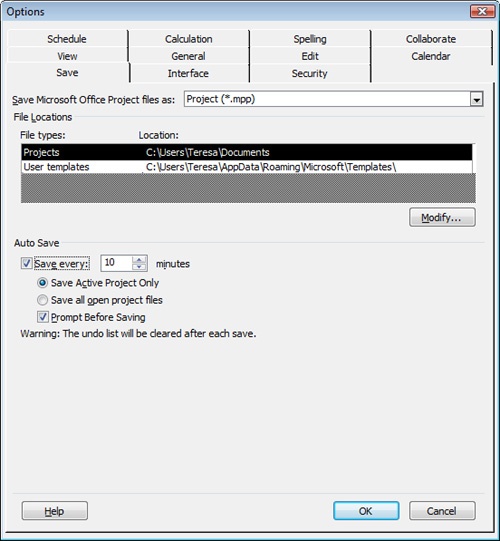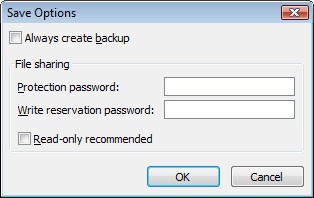After you work hard creating, updating, and tracking your project file, you want to make the file as secure as possible. The further you get into the life cycle of the project, the more information you have in the project plan. The more information stored there, the more devastating a file loss can be.
Although it’s not hard to remember to click the Save button every few minutes while working, you can also have Microsoft Project remember to save for you. You can set Microsoft Project to automatically and regularly save your file every few minutes. This can decrease your risk of losing recent work.
To have Microsoft Project automatically save active and open projects, follow these steps:
Click Tools, Options and then click the Save tab.
Under Auto Save, select the Save Every check box and then enter how often (in minutes) you want Microsoft Project to automatically save your active or open projects (see Figure 29-6).
If you want Microsoft Project to save only the active project, select the Save Active Project Only option.
If you want Microsoft Project to save the active project along with any other open projects, select the Save All Open Project Files option.
It’s always a good policy to have at least two copies of any important computer file. This way, if the file is inadvertently deleted or somehow is corrupted (or if you get a little crazy with your what-if scenarios), you have another file to go back to.
To automatically create backups of active project files, do the following:
Click File, Save As.
In the Save As dialog box, click Tools and then click General Options.
The Save Options dialog box appears (see Figure 29-7).
The backup copy adopts the same file name as the original project file, but it has a different extension (.bak). For example, the backup file of deployment.mpp is deployment.bak.
To restore a backup file as a regular project file, follow these steps:
On the Standard toolbar, click the Open button.
In the Open dialog box, browse, if necessary, to the drive and folder where the backup file is stored.
Be sure that All Files (*.*) is selected in the Files Of Type box.
Otherwise, files ending in .bak will not appear in the list.
Find the backup file and double-click it.
Microsoft Project opens the backup file.
Click File, Save As.
The Save As dialog box appears.
If necessary, browse to the location where you want to save the restored backup project file.
Enter a new file name for the restored backup file.
Make sure that Projects (*.mpp) is selected in the Save As Type box.
Click Save.
Note
Your project BAK file is a great contingency in case your project file is accidentally deleted or corrupted. However, if both the project and the backup are saved on the same drive and that drive crashes, your backup will be lost as well. Remember to periodically save a backup to an alternate drive.
If you are not working in an enterprise project management environment that uses a project server as a central location for your company’s project files, saving your project files to a public network folder is one way to have centralized project files. This enables your company to back up critical files more regularly and reliably. It also provides a convenient location for your co-workers to collaborate on projects. However, it can also enable unauthorized individuals to access files with sensitive or confidential information. Perhaps your project is in its initial phase, and you aren’t ready to share it with the rest of the company. Or, maybe a project has information that should be seen only by a small group of people in your organization. If this is the case, consider assigning a password to prevent unauthorized access to sensitive project files.
There are two types of passwords: Protection and Write Reservation. To assign a password to a project, do the following:
Click File, Save As.
In the Save As dialog box, click Tools and then click General Options.
In the Save Options dialog box, enter the password in either the Protection Password or Write Reservation Password text box.
With a protection password, users can open the project file only if they know the password.
With a write-reservation password, users can view the project file, but they cannot change it.
Click OK.
In the Confirm Password dialog box, type the password again. Click OK.
Note
If you want to remind users to open the project as Read-Only without locking out users who might have forgotten the password, consider the Read-Only Recommended check box. If you select this check box, the next time a user begins to open this file, a message suggests that the user open the file as read-only unless they need to save changes to the file. It then provides the option of opening the file as Read-Only.
If you encounter a problem with Microsoft Project, such as the program freezing or experiencing a "fatal error," you can send the details of the problem to the Microsoft Project development team. When the error happens, a dialog box is displayed, providing the option to restart Microsoft Project and view the details of the error report. If you want to provide information on the problem to Microsoft, click Send The Report To Microsoft. If you don’t want to provide the information, click Don’t Send.
Depending on the severity of the error, you might be able to continue working in Safe Mode, at least to get to the point where you can save your file.
New in Microsoft Office Project 2007 are security options regarding opening files from older file formats. By default, files from older file formats or nondefault file formats are not opened. If you need to open such a file, for example, when you’re bringing older project files into Project 2007 or when you’re importing an Excel file, you must change this security setting.
To do this, click Tools, Options and then click the Security tab. Under Legacy Formats, select the Prompt When Loading Files With Legacy Or Non Default File Format option or the Allow Loading Files With Legacy Or Non Default File Formats option.
You can also set the security level for opening files that contain macros. On the Security tab in the Options dialog box, click the Macro Security button. Select the security option you want on the Security Level tab.


